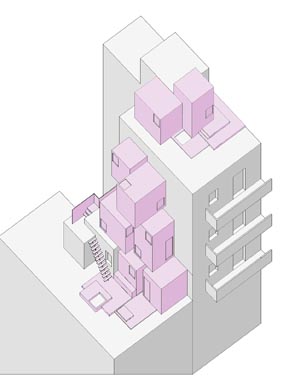

In the contemporary, modern cities, with their heavy rural areas, there is a free area which is depending from the city itself. Its like a projection of the city towards the sky, on the rooftops of the buildings. These multiple areas are part of a network, a host of somekind. They have the ability to receive additional constructions with multiple uses.
This “relationship” also exists in nature, its found between the parasite and its host. A situation of balance, where the two organisms mutually benefit. This is called symbiosis.
The advancement of agile, transient systems who “leech” in the space above the city, gives a solution to the problem of high density and the lack of space and can accommodate common-used areas for the residents of the building and the nearby region.
So, the usage of the rooftops could largely improve the image of the city and could be a start for new “wondering” in architecture as far as the terrain of the city is concerned.
Supervisor: Stylidis Iordanis
Reference Number: 323
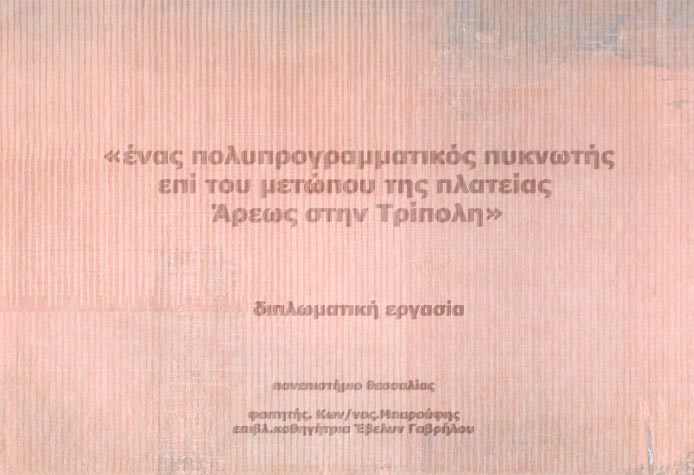

The city of Tripolis is placed in the east of mountain Menalo, in the center of Arkadia. Although her history is not very old, it constituted an important economic and administrative center, mainly because of her valuable geographical position.
For the completion of the diplomatic research, as plot of study was selected the square of Areos, in the city of Tripolis. The square can be characterized as a reliable witness describing best the evolution of place through the years.
The aim of the diplomatic research is the apply of a project, which would transform (ή convert μπορείς να βάλεις, δεν ξέρω) the square in a strong landmark that will not only present her cultural character but also will upgrade living standards of citizens. For this achievement, the square maintains it’s years level form. The space selected as an activity and action area, is the forehead of the buildings along the square. This configuration does not intend to cover it. On the contrary, this project will frame, enhance and also elect the square in order to become the center of cultural developments of the city, as it was in the past.
In the forehead, along the square, it is developed and evolved a polyprogrammmatic capacitor that collects activities and operations, from the past and current, modulating them and placing them among, in this particular space. With the collaboration and coexistence of these elements, the visitor, via spaces, pictures and atmospheres alternations and also with the assistance of the applied audiovisual means, has the possibility to be trained, acquire knowledge and experiences, through entertainment and recreation.
The way of which, this public space of square is charged and operates again, aims to constitute an example for the more general activation of unexploited and sidelined areas in the city web with basic growth rule the dipole education-recreation.
Supervisor: Gavrilou Evelyn
Reference Number: 321
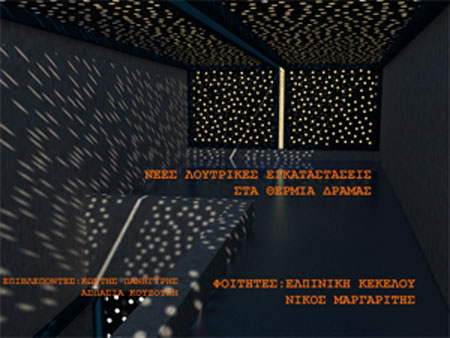

At the northeastern part of the region of Drama, on the Rhodope Mountains, lies the slum settlement of Thermia where thermal baths are located. The 120-hut settlement which are made from all sorts of materials have a special target group which consists of hunters and tourists. These huts are used either as baths that are open to public or for accommodation.
The aim of the City of Paranesti, which owns the site of the baths, is to take advantage of it by replacing the slums with modern bathing and accommodation facilities.
Our suggestion to the City’s project is the creation of a building next to the existing settlement and the establishment of a second community in its limits that will be interdependent with the old one. Thus, our ambition is to create a new balance between the residents in order to make them indispensable to each other.
Even though the settlement of Thermia is developed with the principles of addition, we decided to remove parts or the granite mountain in order to create enclosed areas that could host the functions that we propose. A linear square parallel to the stream which is next to the settlement hosts the bathing facilities. The spatial principles of this square have resulted from an investigation in the old settlement. Five smaller squares, vertically placed to the bigger one, create four mountain arms. These projections are not covered as the region’s granite quality gives us the opportunity to get advantage of it. Even most of its plants are maintained.
Inside these projections and in different heights, holes which are used for accommodation are opened.
Apart from the public thermal baths, each room has its own private bath. The way that these baths are placed in the rooms make them seem like they hang over the five squares.
Supervisors: Paniyiris Costis, Kouzoupi Aspassia
Reference Number: 324
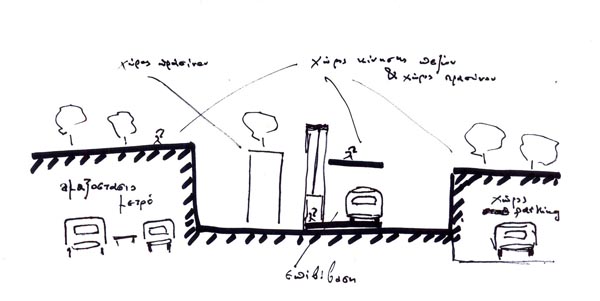

The aim of this project is the placement and the design of the bus terminal of Athens. Given the proximity to major highways, the easy access with metropolitan railway, the position of the region towards the city center and its special conditions, is selected the area of Eleonas, and more specifically, the block where is situated the depot of the Metro, the roof of which it is proposed for this purpose. The different elevation of the roof of the depot from the street level is used as a component intending to separate the movements of pedestrian from the movement of vehicles, and so they are placed at different levels. The adjacent park is also used to improve access at the Station while the park can be used as an extension of the Station and at the same time the station can operate as an extension of the park. Three types of structures are proposed for the needs of the station. In the field of human motion are proposed rectangular pavilion buildings to accommodate as stand points. Around this area are placed the spaces of the vehicles movements, which are formed taking into account their trajectory forming curved spaces at the floor plan level. Finally, the two previous statements are enclosed by topological geometry surfaces, which are developed in a rectangular grid. These elements signal the pedestrian movements either in the form of shelter, or as forming the ground surface. The overall configuration of the bus station aims to provide an opportunity for a synthesis of new urban programs.
Supervisor: Paniyiris Costis
Reference Number: 320
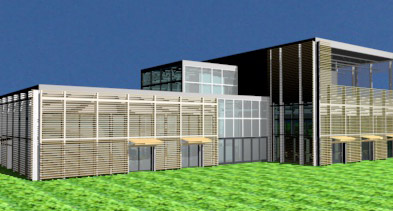

The thesis design project is based on the creation of an agricultural activities centre at the section of Almyros and Efxeinoupolis. The area under study focuses on one city block between the two areas of 27 acres. The chosen section was considered ideal because it is the point where the two regions are joined and still remains untapped by the City Borough of Almyros.
With the use of a questionnaire completed by young children in the area, in relation to what they believe is missing from their city, led to the creation of a multiplex of different activities.
Taking into consideration the fact that the area under study covers an agricultural land, and in relation to the children’s need to learn how to cultivate the earth and produce its goods, we studied the creation of an entertainment centre in relation to the city’s agricultural life.
The centre ‘Playtime’, (recreation), will have as a purpose for children to combine play-time with the land’s cultivation. Teaching spaces, a café – bookstore, an amphitheater, a market where anyone can buy the products cultivated at the centre and other utilities are facilities occupying the interior spaces. The proposed centre’s surrounding area appears as a painting presenting a variety of delimited sections of land that the children themselves will be able to cultivate and in the course of time they will have the chance to see the development of their work.
Supervisor: Trova Vasso
Reference Number: 348
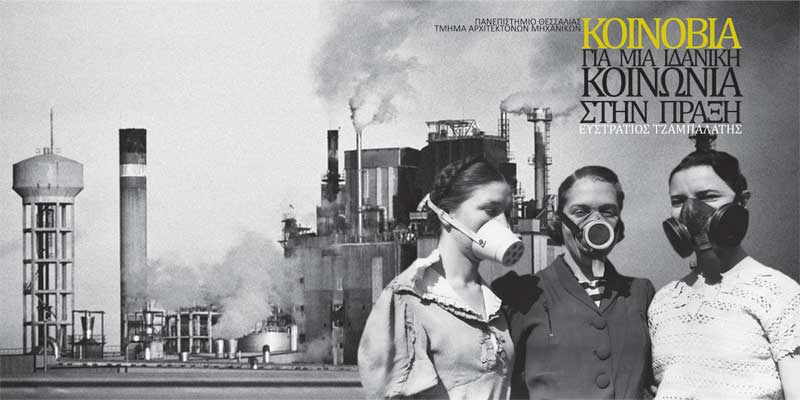

As the time goes by human societies are developing intellectually and are reshaped in a spirit of land-planning, it becomes more clear to us that the initial forms of organisation of societies were much more human. By staring back to the history of humanity we observe that we met in higher level the two basic elements of the subject of social organisation: mutual aid and self-respect to each other.
In societies where the way of production it was not privilege and property of a high social class but of entire society and the goods were produced not only the inferior classes, but from all the individuals of society for the themselves, human used to live and develop himselve with the purest and the most liberal terms. All the other oppressive systems, from the feudalism, the monarchy up to current modern capitalism, the only thing that proved, was their complete failure. Besides by definition, from the moment where these systems have as basic beginning the partition and the breaking into pieces of society in individuals-unit, they cannot function as tools in the sector of organisation and management of human teams and populations.
Putting therefore these two historical moments to face each other, the beginning of humanity and the point in which it is now exist with all this social unrest - en via of a crisis in world level -, is given birth the big question: "Is the suitable moment for the radical change of this world?" the answer is positive and necessary as long as never.
This study therefore tries to give or at least to structure an answer to this question which for some people constitutes a direct need, for others a utopia, and for some others the necessity of completion of the ideal society.
All the radical movements (communistic and anarchic) addopt this fact as the only exit from the oppressive world of powers and social inequalities, but none of these movements answer completely how this fact could work practical. This of course is obliged to the fact that the practices of rebellions cannot prompt the society into the destruction of this aged world, because the theory does not include the utopia and as masterfully reports Lefebvre :
"Today more than ever never, there is not exist thought without utopia. Because it is different the way we are pleased observe, to communicate, to ratify what we find in frond of our eyes. We do not go far away from here, we stand with the eyes nailed in real saying we are realists. But we do not think. It does not exist thought that does not explore a probability, that does not try to find a orientation. Implying of course, that from the moment where we avoid the positivism, which confuse everybody and it is nothing more than the absence of thought, we are in frond of borders, between possible and impossible, that difficult separated from each other. However, it does not exist today and specifically in the field that we are concerned about, thought without utopia."
This study therefore, tries to bridge the gap between ¨before¨ and ¨after¨ and it gives some food for thought, on how it could be structured the ideal society in practice.
Supervisor: Stylidis Iordanis
Reference Number: 325
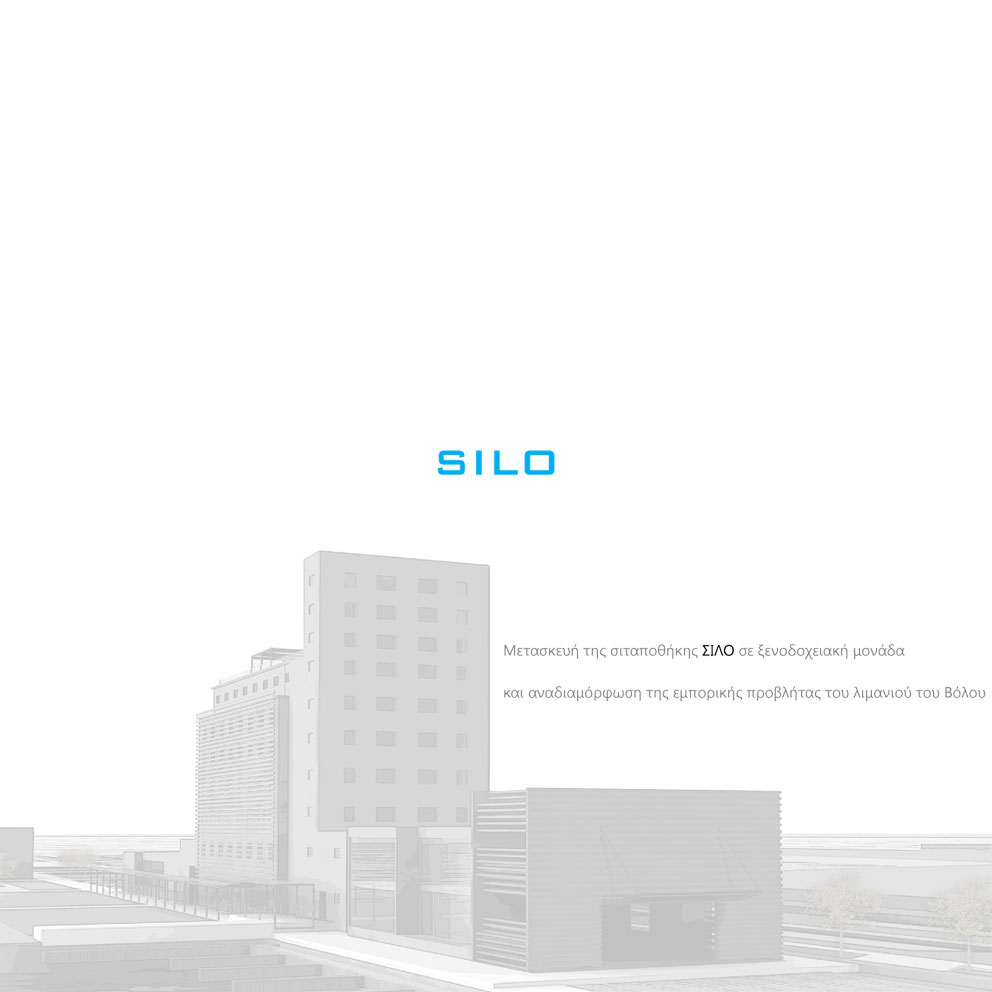

The objective of this thesis is the reconstruction of the commercial pier of the port of Volos and the conversion of the grain SILO to a hotel.
One of the basic characteristics of the city of Volos is its extensive seafront, which acts complementary to the residential areas of the city or has the potential of a future integration into the city.
The free open space of the pier, which now allows movement of the stevedore’s machinery, can be reconstructed so as to facilitate the expansion of the urban region by connecting the network of streets, bikeways and sidewalks to the existing infrastructures of the city. The Silo building, and thus the pier, are located at a strategic point, and form the boundary between the industrial and the urban front of the coastline.
The aim of the project development is the construction of a new residential unit with mixed uses of tourism / recreation, commerce and culture. This project will be just the beginning of a future urbanization of the central pier of the harbor, which will activate the seafront of the city and will connect the park Anavros with the urban core of Palia, by creating a network of walkways, bikeways and parks.
The transformation of Silo to a hotel unit and the development of new private and public spaces, aims to convert Volos to a metropolitan center with more recreational opportunities, and to enhance the touristic development of the city.
Supervisor: Kotionis Zissis
Reference Number: 358

